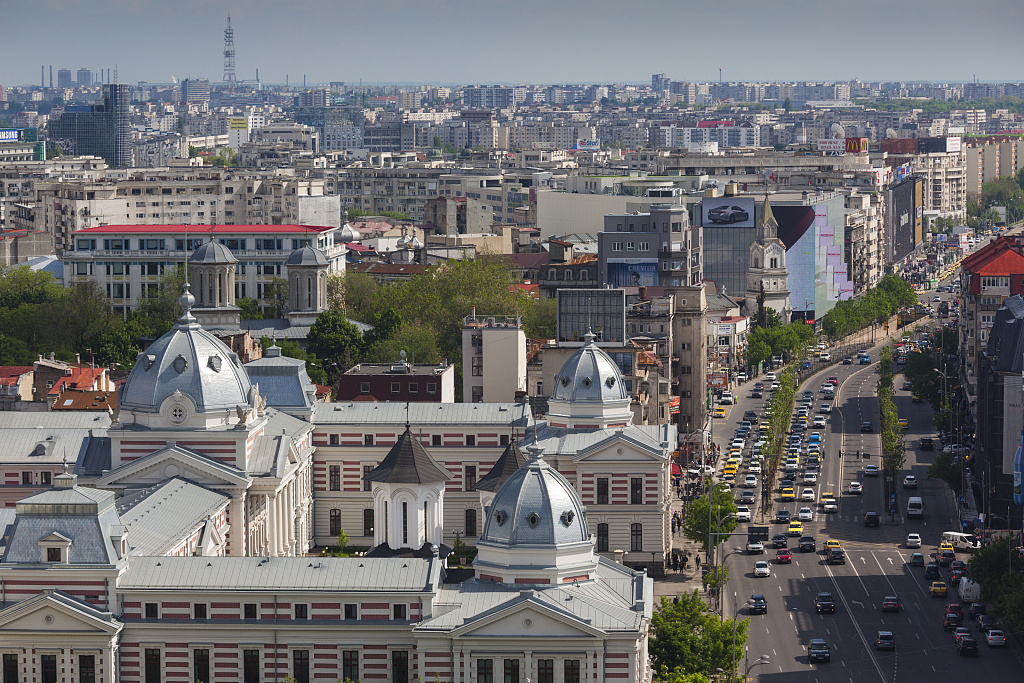Romania is located in the northeast of the Balkan peninsula in southeast Europe. It borders Ukraine and Moldova in the north and northeast, Bulgaria in the south, Serbia and Hungary in the southwest and northwest, and the black sea in the southeast.
The coastline is 245 kilometers, the temperate is continental climate and the average annual precipitation is 637 mm.

(Photo: VCG)
FACTS
Name: Romania
Capital: Bucharest
Area:238,391 square kilometers
Population: 19.52 million (2018). Romanians account for 88.6%, Hungarians 6.5%, Roma (i.e., gypsies) 3.2%, Germans and Ukrainians 0.2% each, and the rest were Russian, Turkish, tartar and others.
National Day: December 1 (1918 national unification day);
Administrative districts:1 municipality directly under the central government and 41 provinces, with cities and townships under it.
The official languages: Romanian
The main minority language: Hungarian.
The resources: The main mineral deposits include petroleum, natural gas, coal, bauxite, gold, silver, iron, manganese, antimony, salt, uranium, lead, etc.
Agriculture: Agriculture occupies an important position in Romania's economy. Fertile land, adequate rain, good agricultural production conditions. The grain output in 2017 was 27 million tons. China has 14.7 million hectares of agricultural land, including 10 million hectares of arable land. Mainly planted wheat, corn, sunflowers, potatoes, apples, grapes.
The Main export products: footwear, garments, textiles.
The Main import products: mechanical and electrical appliances, mineral products, petroleum products.
ECONOMIC:
Romania began to transition from a planned economy to a market economy after the 1989 upheaval. From 2000 to 2008, the economy grew year by year. Affected by the international financial crisis, the economy experienced negative growth in 2009 and 2010. Since 2011, the economy has been stabilizing and growing year after year. In 2015, 2016 and 2017, the economic growth rate was 3.7 percent, 4.8 percent and 7 percent respectively.
The key economic data for Romania's main economic data in 2018 are as follows:
GDP: 197.7 billion euro.
Per capita GDP: 10,000 Euros.
Economic growth rate: 4.1%.
Currency name: Leu/RON.
Exchange rate: 1 euro ≈ 4.66 leu;$1.≈ 4 leu (Dec. 28, 2018).
Inflation: 4.6%.
Unemployment: 3.8%.
By the end of 2018, Romania had foreign exchange reserves of 35.9 billion Euros and gold reserves worth 103.7 tons. Foreign debt of 100 billion Euros.
Foreign trade: at present, Romania has economic and trade exchanges with more than 180 countries and regions in the world. In 2018, total trade volume reached 150.6 billion Euros, up 8.8% year-on-year.
POLITICS:
In November 2014, Romania held a presidential election, and sibiu mayor Johannes was elected. In December 2016, Romania held parliamentary elections, which were jointly won by the social Democratic Party and the liberal democratic alliance. In January 2017, the government was formed and Sorin GRINDEANU became prime minister. In June, the government changed and Mihai TUDOSE became the prime minister. In January 2018, Romania's government change again, the social Democratic Party (SPD), women's group President Viorica DSNCILA was prime minister.
RELATIONSHIP WITH CHINA

(Photo: VCG)
China and Romania have maintained friendly and cooperative relations since the establishment of diplomatic ties on October 5, 1949. Romania's governments stick to "one China" stand. In 2013, the comprehensive friendly and cooperative partnership between the People's Republic of China and Romania grew from strength to strength with new progress made in their practical cooperation across the board. The two countries maintained frequent high-level exchanges.
In November 2013, Premier Li Keqiang visited Romania and attended the Meeting of Heads of Government of China and Central and Eastern European (CEE) Countries held in Bucharest. n. At the end of June and early July, Prime Minister Ponta attended the Local Leaders' Meeting of China and CEE Countries in Chongqing. During his stay in Beijing, President Xi Jinping and Premier Li Keqiang both met with him.
These years, exchanges between the legislatures and the political parties of the two countries kept expanding and positive progress was made in economic and trade cooperation. Exchanges and cooperation in such areas as culture, education, military and justice as well as at the local level were vibrant.


